Wildfire Risk Assessment for Strategic Forest Management in the Southern United States: A Bayesian Network Modeling Approach
Abstract
:1. Introduction
2. Materials and Methods
2.1. Study Area
2.2. Expert Elicitation
2.3. Data Aggregation and Synthesis
2.4. Bayesian Network Model
2.5. Model Components and Data
2.5.1. Potential for Hazardous Fire
2.5.2. Vulnerable People and Ecosystem Services
2.5.3. The Utility of Fuel Reduction to Reduce Risk
2.6. Sensitivity Analysis
3. Results
3.1. Potential for Hazardous Fire
3.2. Vulnerable People and Ecosystem Services
3.3. Wildfire Risk
3.4. Utility of Fuel Reduction
3.5. Sensitivity Analysis
4. Discussion
5. Summary
Author Contributions
Funding
Data Availability Statement
Acknowledgments
Conflicts of Interest
Appendix A
| Factor 2: Wildfire Intensity and Fire-Prone Forests | Loadings | Factor 4: Population, Infrastructure and WUI | Loadings | Factor 6: Wildfire Potential | Loadings | Factor 7: Social Vulnerability | Loadings |
|---|---|---|---|---|---|---|---|
| Longleaf/Slash pine | 0.613 | Housing unit density | 0.989 | Risk to potential structures | 0.945 | SVI overall | 0.967 |
| Proportion of watersheds with high-to-very high wildfire harzard potential | 0.557 | Population density | 0.989 | Burn Probability | 0.937 | SVI socio economic | 0.811 |
| Flame length exceedance (8 ft) | 0.554 | Developed land cover | 0.856 | Wildfire hazard | 0.718 | SVI housing and transportation | 0.755 |
| Flame length exceedance (4 ft) | 0.536 | Proportion impervious | 0.672 | Threatened and endangered wildlife species | 0.341 | SVI household composition and disability | 0.604 |
| Small non-stocked size class | 0.536 | Wildland urban interface | 0.350 | Threatened and endangered species total | 0.314 | SVI minority status and language | 0.428 |
| Max downward radiation | 0.463 | Wildland urban interface risk | −0.651 | ||||
| Maximum temperature normal | 0.436 | ||||||
| Loblolly/Shortleaf pine | 0.409 | ||||||
| Bottomland/Moist soil hardwood | 0.378 | ||||||
| Wildfire hazard | 0.344 | ||||||
| SVI minority status and language | 0.343 | ||||||
| Natural-caused fires, 2000–2018 | 0.330 | ||||||
| Upland hardwood | −0.819 | ||||||
| Downstream drinking water population | −0.719 | ||||||
| Watershed importance for surface drinking water | −0.623 | ||||||
| Large forest stand size | −0.407 | ||||||
| SPEI normal (30-yr) | −0.328 |
Appendix B
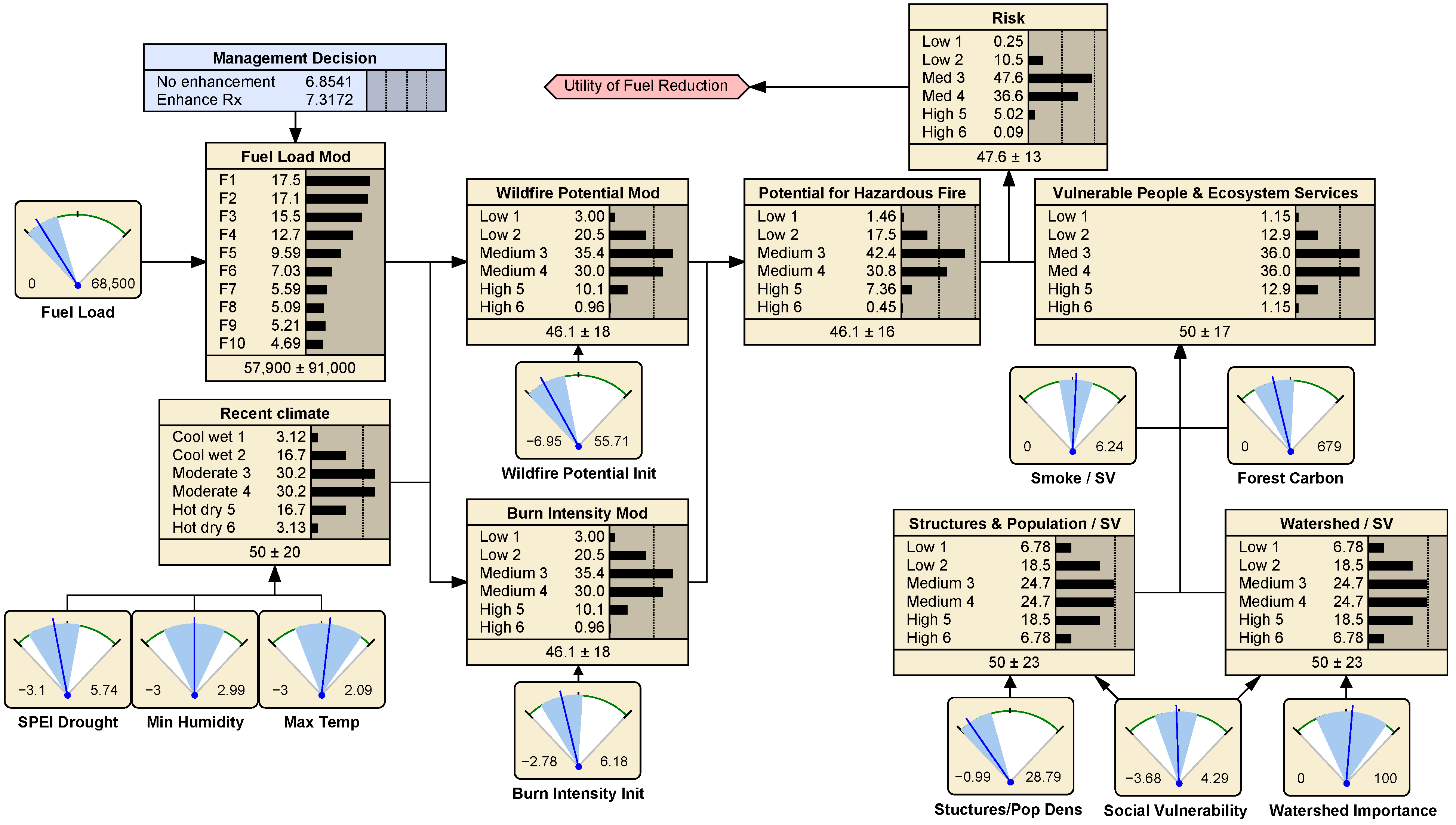
Appendix C
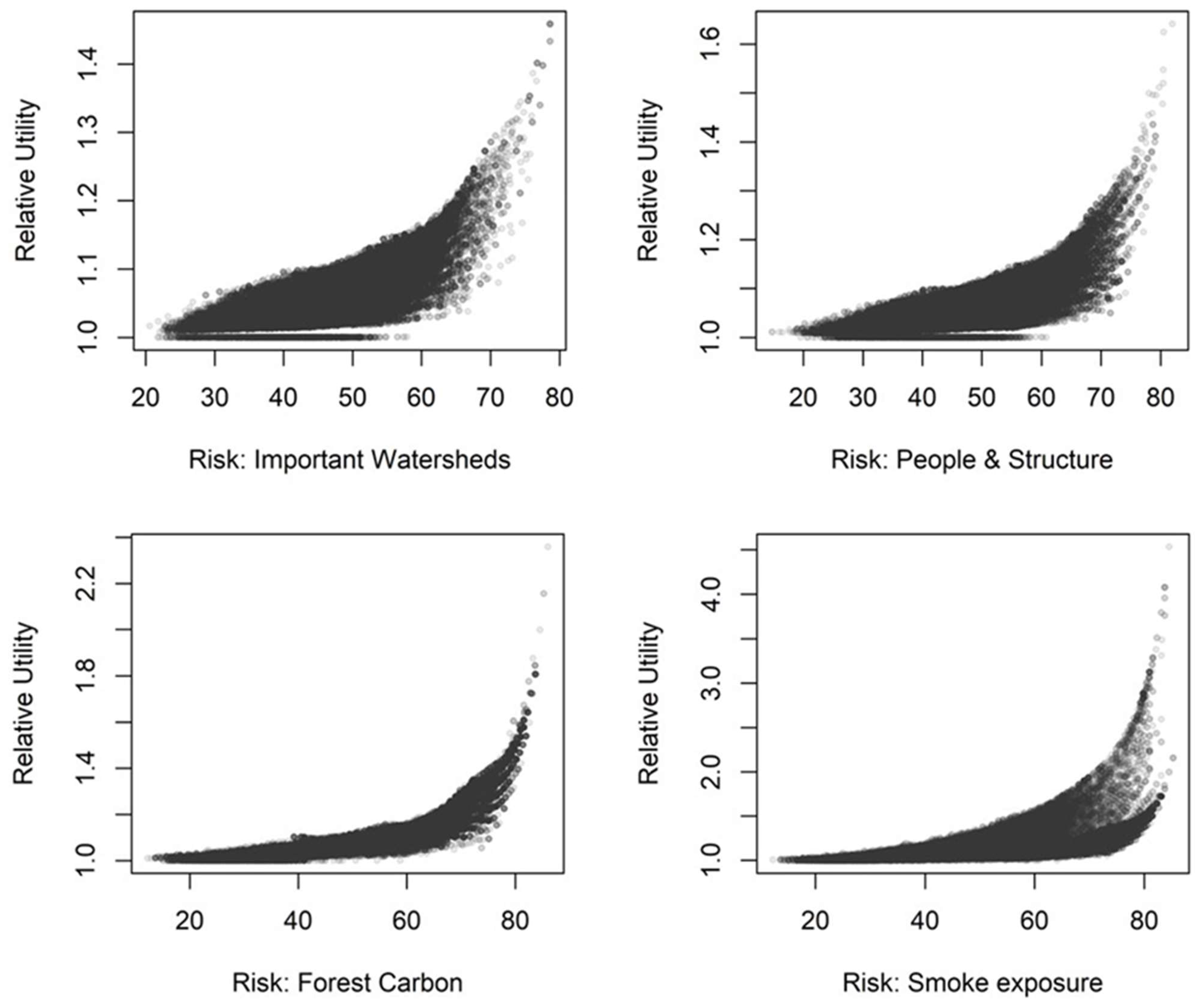
References
- Radeloff, V.C.; Helmers, D.P.; Kramer, H.A.; Mockrin, M.H.; Alexandre, P.M.; Bar-Massada, A.; Butsic, V.; Hawbaker, T.J.; Martinuzzi, S.; Syphard, A.D.; et al. Rapid growth of the US wildland-urban interface raises wildfire risk. Proc. Natl. Acad. Sci. USA 2018, 115, 3314–3319. [Google Scholar] [CrossRef] [PubMed]
- USDA Forest Service. Confronting the Wildfire Crisis: A Strategy for Protecting Communities and Improving Resilience in America’s Forests; FS-1187a; USDA Forest Service: Washington, DC, USA, 2022.
- Vose, J.M.; Peterson, D.L.; Fettig, C.J.; Halofsky, J.E.; Hiers, J.K.; Keane, R.E.; Loehman, R.; Stambaugh, M.C. Fire and Forests in the 21st Century: Managing Resilience Under Changing Climates and Fire Regimes in USA Forests. In Fire Ecology and Management: Past, Present, and Future of US Forested Ecosystems; Greenberg, C.H., Collins, B., Eds.; Springer: Cham, Switzerland, 2021; pp. 465–502. [Google Scholar]
- Kelly, L.T.; Giljohann, K.M.; Duane, A.; Aquilue, N.; Archibald, S.; Batllori, E.; Bennett, A.F.; Buckland, S.T.; Canelles, Q.; Clarke, M.F.; et al. Fire and biodiversity in the Anthropocene. Science 2020, 370, eabb0355. [Google Scholar] [CrossRef] [PubMed]
- Reid, C.E.; Brauer, M.; Johnston, F.H.; Jerrett, M.; Balmes, J.R.; Elliott, C.T. Critical Review of Health Impacts of Wildfire Smoke Exposure. Environ. Health Perspect. 2016, 124, 1334–1343. [Google Scholar] [CrossRef] [PubMed]
- Thompson, M.P.; Calkin, D.E. Uncertainty and risk in wildland fire management: A review. J. Environ. Manag. 2011, 92, 1895–1909. [Google Scholar] [CrossRef] [PubMed]
- Dunn, C.J.; O’Connor, C.D.; Abrams, J.; Thompson, M.P.; Calkin, D.E.; Johnston, J.D.; Stratton, R.; Gilbertson-Day, J. Wildfire risk science facilitates adaptation of fire-prone social-ecological systems to the new fire reality. Environ. Res. Lett. 2020, 15, 025001. [Google Scholar] [CrossRef]
- Ager, A.A.; Kline, J.D.; Fischer, A.P. Coupling the Biophysical and Social Dimensions of Wildfire Risk to Improve Wildfire Mitigation Planning. Risk Anal. 2015, 35, 1393–1406. [Google Scholar] [CrossRef] [PubMed]
- Davies, I.P.; Haugo, R.D.; Robertson, J.C.; Levin, P.S. The unequal vulnerability of communities of color to wildfire. PLoS ONE 2018, 13, e0205825. [Google Scholar] [CrossRef]
- Palaiologou, P.; Ager, A.A.; Nielsen-Pincus, M.; Evers, C.R.; Day, M.A. Social vulnerability to large wildfires in the western USA. Landsc. Urban Plan 2019, 189, 99–116. [Google Scholar] [CrossRef]
- Scott, J.H.; Thompson, M.P.; Calkin, D.E. A Wildfire Risk Assessment Framework for Land and Resource Management; Gen. Tech. Rep. RMRS-GTR-315; USDA Forest Service, Rocky Mountain Research Station: Fort Collins, CO, USA, 2013; 83p.
- EPA. Comparative Assessment of the Impacts of Prescribed Fire versus Wildfire (CAIF): A Case Study in the Western U.S.; EPA: Washington, DC, USA, 2021.
- Hunter, M.E.; Robles, M.D. Tamm review: The effects of prescribed fire on wildfire regimes and impacts: A framework for comparison. For. Ecol. Manag. 2020, 475, 118435. [Google Scholar] [CrossRef]
- Ott, J.E.; Kilkenny, F.F.; Jain, T.B. Fuel treatment effectiveness at the landscape scale: A systematic review of simulation studies comparing treatment scenarios in North America. Fire Ecol. 2023, 19, 10. [Google Scholar] [CrossRef]
- Urza, A.K.; Hanberry, B.B.; Jain, T.B. Landscape-scale fuel treatment effectiveness: Lessons learned from wildland fire case studies in forests of the western United States and Great Lakes region. Fire Ecol. 2023, 19, 1. [Google Scholar] [CrossRef]
- Fernandes, P.M. Empirical Support for the Use of Prescribed Burning as a Fuel Treatment. Curr. For. Rep. 2015, 1, 118–127. [Google Scholar] [CrossRef]
- Stephens, S.L.; McIver, J.D.; Boerner, R.E.J.; Fettig, C.J.; Fontaine, J.B.; Hartsough, B.R.; Kennedy, P.L.; Schwilk, D.W. The Effects of Forest Fuel-Reduction Treatments in the United States. BioScience 2012, 62, 549–560. [Google Scholar] [CrossRef]
- Addington, R.N.; Hudson, S.J.; Hiers, J.K.; Hurteau, M.D.; Hutcherson, T.F.; Matusick, G.; Parker, J.M. Relationships among wildfire, prescribed fire, and drought in a fire-prone landscape in the south-eastern United States. Int. J. Wildland Fire 2015, 24, 778–783. [Google Scholar] [CrossRef]
- Arkle, R.S.; Pilliod, D.S.; Welty, J.L. Pattern and process of prescribed fires influence effectiveness at reducing wildfire severity in dry coniferous forests. For. Ecol. Manag. 2012, 276, 174–184. [Google Scholar] [CrossRef]
- Moritz, M.A.; Hazard, R.; Johnston, K.; Mayes, M.; Mowery, M.; Oran, K.; Parkinson, A.M.; Schmidt, D.A.; Wesolowski, G. Beyond a Focus on Fuel Reduction in the WUI: The Need for Regional Wildfire Mitigation to Address Multiple Risks. Front. For. Glob. Chang. 2022, 5, 848254. [Google Scholar] [CrossRef]
- Merritta, W.S.; Ticehursta, J.L.; Pollinoa, C.; Fua, B. The value of using Bayesian Networks in Environmental Decision Support Systems to support natural resource management. In Proceedings of the 5th International Congress on Environmental Modelling and Software, Ottawa, ON, Canada, 5–8 July 2010. [Google Scholar]
- Conroy, M.J.; Peterson, J.T. Decision Making in Natural Resource Management: A Structured, Adaptive Approach; Wiley-Blackwell: Oxford, UK, 2013; p. 456. [Google Scholar]
- Penman, T.D.; Cirulis, B.; Marcot, B.G. Bayesian decision network modeling for environmental risk management: A wildfire case study. J. Environ. Manag. 2020, 270, 110735. [Google Scholar] [CrossRef]
- Dlamini, W.M. A Bayesian belief network analysis of factors influencing wildfire occurrence in Swaziland. Environ. Model. Softw. 2010, 25, 199–208. [Google Scholar] [CrossRef]
- Carriger, J.F.; Thompson, M.; Barron, M.G. Causal Bayesian networks in assessments of wildfire risks: Opportunities for ecological risk assessment and management. Integr. Environ. Assess. 2021, 17, 1168–1178. [Google Scholar] [CrossRef]
- Sevinc, V.; Kucuk, O.; Goltas, M. A Bayesian network model for prediction and analysis of possible forest fire causes. For. Ecol. Manag. 2020, 457, 117723. [Google Scholar] [CrossRef]
- Zwirglmaier, K.; Papakosta, P.; Straub, D. Learning a Bayesian network model for predicting wildfire behavior. In Proceedings of the 11th International Conference on Structural Safety and Reliability, New York, NY, USA, 16–20 June 2013. [Google Scholar]
- Liu, S.; McGree, J.; Ge, Z.; Xie, Y. 2—Classification Methods. In Computational and Statistical Methods for Analysing Big Data with Applications; Liu, S., McGree, J., Ge, Z., Xie, Y., Eds.; Academic Press: San Diego, CA, USA, 2016; pp. 7–28. [Google Scholar]
- McCann, R.K.; Marcot, B.G.; Ellis, R. Bayesian belief networks: Applications in ecology and natural resource management. Can. J. For. Res. 2006, 36, 3053–3062. [Google Scholar] [CrossRef]
- Pollino, C.A.; Henderson, C. Bayesian networks: A guide for their application in natural resource management and policy. Landsc. Log. Tech. Rep. 2010, 14, 48. [Google Scholar]
- Scott, J.H.; Brough, A.M.; Gilbertson-Day, J.W.; Dillon, G.K.; Moran, C. Wildfire Risk to Communities: Methods for Geospatial Datasets for Populated Areas in the United States; USDA, Forest Service Research Data Archive: Fort Collins, CO, USA, 2020. [CrossRef]
- Thompson, M.P.; Scott, J.; Helmbrecht, D.; Calkin, D.E. Integrated wildfire risk assessment: Framework development and application on the Lewis and Clark National Forest in Montana, USA. Integr. Environ. Assess. Manag. 2013, 9, 329–342. [Google Scholar] [CrossRef] [PubMed]
- Kobziar, L.N.; Godwin, D.; Taylor, L.; Watts, A.C. Perspectives on trends, effectiveness, and impediments to prescribed burning in the southern US. Forests 2015, 6, 561–580. [Google Scholar] [CrossRef]
- Marcot, B.G.; Steventon, J.D.; Sutherland, G.D.; McCann, R.K. Guidelines for developing and updating Bayesian belief networks applied to ecological modeling and conservation. Can. J. For. Res. 2006, 36, 3063–3074. [Google Scholar] [CrossRef]
- Mitchell, R.J.; Liu, Y.; O’Brien, J.J.; Elliott, K.J.; Starr, G.; Miniat, C.F.; Hiers, J.K. Future climate and fire interactions in the southeastern region of the United States. For. Ecol. Manag. 2014, 327, 316–326. [Google Scholar] [CrossRef]
- Stanturf, J.A.; Goodrick, S.L. Fire. In The Southern Forest Futures Project; Gen. Tech. Rep. SRS-GTR-178; Wear, D.N., Greis, J.G., Eds.; U.S. Department of Agriculture, Forest Service, Southern Research Station: Asheville, NC, USA, 2013; pp. 509–542. [Google Scholar]
- Gould, N.P.; Pomara, L.Y.; Nepal, S.; Goodrick, S.L.; Lee, D.C. Mapping firescapes for wild and prescribed fire management: A landscape classification approach. Land 2023, in press. [Google Scholar]
- Smith, A.M.S.; Kolden, C.A.; Paveglio, T.B.; Cochrane, M.A.; Bowman, D.M.J.S.; Moritz, M.A.; Kliskey, A.D.; Alessa, L.; Hudak, A.T.; Hoffman, C.M.; et al. The Science of Firescapes: Achieving Fire-Resilient Communities. Bioscience 2016, 66, 130–146. [Google Scholar] [CrossRef]
- Wildland Fire Leadership Council. The National Strategy: The Final Phase in the Development of the National Cohesive Wildland Fire Management Strategy; United States Department of Agriculture and United States Department of the Interior: Washington, DC, USA, 2014; pp. 1–93.
- Brownell, K.D.; Roberto, C.A. Strategic science with policy impact. Lancet 2015, 385, 2445–2446. [Google Scholar] [CrossRef]
- Lemos, M.C.; Morehouse, B.J. The co-production of science and policy in integrated climate assessments. Glob. Environ. Chang. 2005, 15, 57–68. [Google Scholar] [CrossRef]
- Parviainen, T.; Kuikka, S.; Haapasaari, P. Enhancing science-policy interface in marine environmental governance: Oil spill response models as boundary objects in the Gulf of Finland, Baltic Sea. Mar. Policy 2022, 135, 104863. [Google Scholar] [CrossRef]
- Moe, S.J.; Carriger, J.F.; Glendell, M. Increased Use of Bayesian Network Models Has Improved Environmental Risk Assessments. Integr. Environ. Assess. Manag. 2021, 17, 53–61. [Google Scholar] [CrossRef] [PubMed]
- Kaikkonen, L.; Parviainen, T.; Rahikainen, M.; Uusitalo, L.; Lehikoinen, A. Bayesian Networks in Environmental Risk Assessment: A Review. Integr. Environ. Assess. Manag. 2021, 17, 62–78. [Google Scholar] [CrossRef] [PubMed]
- Turner, B.L.; Kasperson, R.E.; Matson, P.A.; McCarthy, J.J.; Corell, R.W.; Christensen, L.; Eckley, N.; Kasperson, J.X.; Luers, A.; Martello, M.L.; et al. A framework for vulnerability analysis in sustainability science. Proc. Natl. Acad. Sci. USA 2003, 100, 8074–8079. [Google Scholar] [CrossRef] [PubMed]
- Norsys Software Corp. Bayes Network Software. Available online: https://www.norsys.com/ (accessed on 28 August 2020).
- Havron, A.; Goldfinger, C.; Henkel, S.; Marcot, B.G.; Romsos, C.; Gilbane, L. Mapping marine habitat suitability and uncertainty of Bayesian networks: A case study using Pacific benthic macrofauna. Ecosphere 2017, 8, e01859. [Google Scholar] [CrossRef]
- Shojaei Estabragh, Z.; Riahi Kashani, M.M.; Jeddi Moghaddam, F.; Sari, S.; Taherifar, Z.; Moradi Moosavy, S.; Sadeghi Oskooyee, K. Bayesian network modeling for diagnosis of social anxiety using some cognitive-behavioral factors. Netw. Model. Anal. Health Inform. Bioinform. 2013, 2, 257–265. [Google Scholar] [CrossRef]
- Wilhere, G.F. Using Bayesian networks to incorporate uncertainty in habitat suitability index models. J. Wildl. Manag. 2012, 76, 1298–1309. [Google Scholar] [CrossRef]
- Zou, X.; Yue, W.L. A Bayesian Network Approach to Causation Analysis of Road Accidents Using Netica. J. Adv. Transp. 2017, 2017, 2525481. [Google Scholar] [CrossRef]
- Nepal, S.; Pomara, L.Y.; Gould, N.P.; Lee, D.C. Wildfire Risk Assessment for Strategic Forest Management in the Southern United States: A Bayesian Network Modeling Approach [Data Set]; Zenodo: Geneva, Switzerland, 2023. [Google Scholar] [CrossRef]
- LANDFIRE. Fuel Charactersistic Classification System Fuelbeds 2022, LANDFIRE 2.2.0. Available online: https://www.landfire.gov/version_download.php (accessed on 3 May 2022).
- Costanza, J.K.; Koch, F.H.; Reeves, M.C. Future exposure of forest ecosystems to multi-year drought in the United States. Ecosphere 2023, 14, e4525. [Google Scholar] [CrossRef]
- McEvoy, D.J.; Hobbins, M.; Brown, T.J.; VanderMolen, K.; Wall, T.; Huntington, J.L.; Svoboda, M. Establishing Relationships between Drought Indices and Wildfire Danger Outputs: A Test Case for the California-Nevada Drought Early Warning System. Climate 2019, 7, 52. [Google Scholar] [CrossRef]
- Joyce, L.A.; Coulson, D.P. RPA Historical Observational Data (1979–2015) for the Conterminous United States at the 1/24 Degree Grid Scale Based on MACA Training Data (METDATA), 2nd ed.; U.S. Department of Agriculture: Washington, DC, USA, 2020. [CrossRef]
- Abatzoglou, J.T. Development of gridded surface meteorological data for ecological applications and modelling. Int. J. Climatol. 2013, 33, 121–131. [Google Scholar] [CrossRef]
- Abatzoglou, J.T.; Brown, T.J. A comparison of statistical downscaling methods suited for wildfire applications. Int. J. Climatol. 2012, 32, 772–780. [Google Scholar] [CrossRef]
- Vicente-Serrano, S.M.; Beguería, S.; López-Moreno, J.I. A multiscalar drought index sensitive to global warming: The standardized precipitation evapotranspiration index. J. Clim. 2010, 23, 1696–1718. [Google Scholar] [CrossRef]
- Kondo, M.C.; Reid, C.E.; Mockrin, M.H.; Heilman, W.E.; Long, D. Socio-demographic and health vulnerability in prescribed-burn exposed versus unexposed counties near the National Forest System. Sci. Total Environ. 2022, 806, 150564. [Google Scholar] [CrossRef] [PubMed]
- Gaither, C.; Goodrick, S.; Murphy, B.; Poudyal, N. An Exploratory Spatial Analysis of Social Vulnerability and Smoke Plume Dispersion in the U.S. South. Forests 2015, 6, 1397–1421. [Google Scholar] [CrossRef]
- Wilson, B.T.; Knight, J.F.; McRoberts, R.E. Harmonic regression of Landsat time series for modeling attributes from national forest inventory data. ISPRS J. Photogramm. Remote Sens. 2018, 137, 29–46. [Google Scholar] [CrossRef]
- Wilson, B.T.; Lister, A.J.; Riemann, R.I. A nearest-neighbor imputation approach to mapping tree species over large areas using forest inventory plots and moderate resolution raster data. For. Ecol. Manag. 2012, 271, 182–198. [Google Scholar] [CrossRef]
- Mack, E.; Lilja, R.; Claggett, S.; Sun, G.; Caldwell, P. Forests to Faucets 2.0: Connecting Forests, Water, and Communities; GTR-WO-99; United States Department of Agriculture Forest Service: Washington, DC, USA, 2022; p. 19.
- Pearl, J. Probabilistic Reasoning in Intelligent Systems: Networks of Plausible Inference; Revised Second Printing, Revised & Updated Edition; Morgan Kaufmann Publishers: San Francisco, CA, USA, 1988. [Google Scholar]
- Steuer, R.; Kurths, J.; Daub, C.O.; Weise, J.; Selbig, J. The mutual information: Detecting and evaluating dependencies between variables. Bioinformatics 2002, 18, S231–S240. [Google Scholar] [CrossRef]
- Wear, D.N.; Greis, J.G. The Southern Forest Futures Project: Technical Report; SRS-178; US Department of Agriculture Forest Service: Washington, DC, USA, 2013; p. 542.
- Gramley, M. Fire in the South: A Report by the Southern Group of State Foresters; Southern Group of State Foresters: Winder, GA, USA, 2005; Volume 177. [Google Scholar]
- Dillon, G.K.; Menakis, J.; Fay, F. Wildland fire potential: A tool for assessing wildfire risk and fuels management needs. In Proceedings of the Large Wildland Fires Conference, Missoula, MT, USA, 19–23 May 2014; pp. 60–76. [Google Scholar]
- Finney, M.A.; McHugh, C.W.; Grenfell, I.C.; Riley, K.L.; Short, K.C. A simulation of probabilistic wildfire risk components for the continental United States. Stoch. Environ. Res. Risk Assess. 2011, 25, 973–1000. [Google Scholar] [CrossRef]
- Kreitler, J.; Thompson, M.P.; Vaillant, N.M.; Hawbaker, T.J. Cost-effective fuel treatment planning: A theoretical justification and case study. Int. J. Wildland Fire 2020, 29, 42–56. [Google Scholar] [CrossRef]
- Noss, R.F. Fire Ecology of Florida and the Southeastern Coastal Plain; University Press of Florida: Gainesville, FL, USA, 2018. [Google Scholar]
- National Drought Mitigation Center. Percent Area in U.S. Drought Monitor Categories. Available online: https://droughtmonitor.unl.edu/About.aspx (accessed on 26 October 2022).
- Hoover, K.; Riddle, A.A. U.S. Forest Ownership and Management: Background and Issues for Congress; CRS Report-R46976; Congressional Research Service: Washington, DC, USA, 2021.
- Stroman, D.A.; Kreuter, U.P.; Wonkka, C.L. Landowner perceptions of woody plants and prescribed fire in the Southern Plains, USA. PLoS ONE 2020, 15, e0238688. [Google Scholar] [CrossRef] [PubMed]
- Palsa, E.; Bauer, M.; Evers, C.; Hamilton, M.; Nielsen-Pincus, M. Engagement in local and collaborative wildfire risk mitigation planning across the western U.S.-Evaluating participation and diversity in Community Wildfire Protection Plans. PLoS ONE 2022, 17, e0263757. [Google Scholar] [CrossRef] [PubMed]
- Abreu, S.J.D. Toward a Holistic Approach: Considerations for Improved Collaboration in Wildfire Management. Open J. For. 2022, 12, 107–121. [Google Scholar] [CrossRef]
- Sturtevant, V.; Jakes, P. Collaborative Planning to Reduce Risk. In Wildfire Risk: Human Perceptions and Management Implications; Martin, W.E., Raish, C., Kent, B., Eds.; Routledge: New York, NY, USA, 2007; pp. 44–64. [Google Scholar]
- Schultz, C.A.; Thompson, M.P.; McCaffrey, S.M. Forest Service fire management and the elusiveness of change. Fire Ecol. 2019, 15, 13. [Google Scholar] [CrossRef]
- Thompson, M.P.; Bowden, P.; Brough, A.; Scott, J.H.; Gilbertson-Day, J.; Taylor, A.; Anderson, J.; Haas, J.R. Application of Wildfire Risk Assessment Results to Wildfire Response Planning in the Southern Sierra Nevada, California, USA. Forests 2016, 7, 64. [Google Scholar] [CrossRef]
- Wang, H.; Khan, F.; Chen, B.; Lu, Z. An Approximate Modelling Method for Industrial l-lysine Fermentation Process. In Computer Aided Chemical Engineering; Gernaey, K.V., Huusom, J.K., Gani, R., Eds.; Elsevier: Amsterdam, The Netherlands, 2015; Volume 37, pp. 461–466. [Google Scholar]
- Chee, Y.E.; Wilkinson, L.; Nicholson, A.E.; Quintana-Ascencio, P.F.; Fauth, J.E.; Hall, D.; Ponzio, K.J.; Rumpff, L. Modelling spatial and temporal changes with GIS and Spatial and Dynamic Bayesian Networks. Environ. Model. Softw. 2016, 82, 108–120. [Google Scholar] [CrossRef]
- Marcot, B.G.; Penman, T.D. Advances in Bayesian network modelling: Integration of modelling technologies. Environ. Model. Softw. 2019, 111, 386–393. [Google Scholar] [CrossRef]
- Rachid, G.; Alameddine, I.; Najm, M.A.; Qian, S.; El-Fadel, M. Dynamic Bayesian Networks to Assess Anthropogenic and Climatic Drivers of Saltwater Intrusion: A Decision Support Tool Toward Improved Management. Integr. Environ. Assess. Manag. 2021, 17, 202–220. [Google Scholar] [CrossRef]
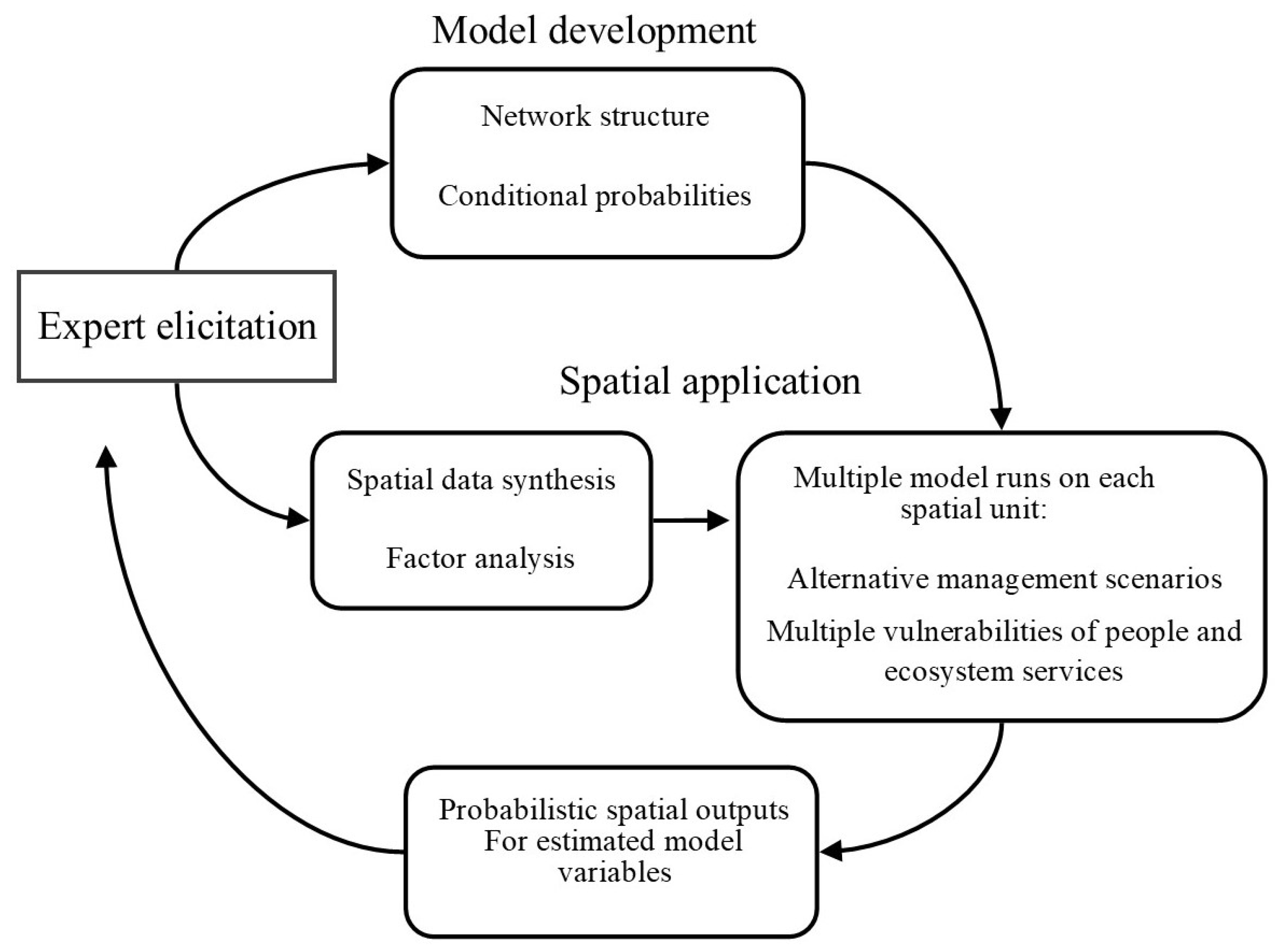
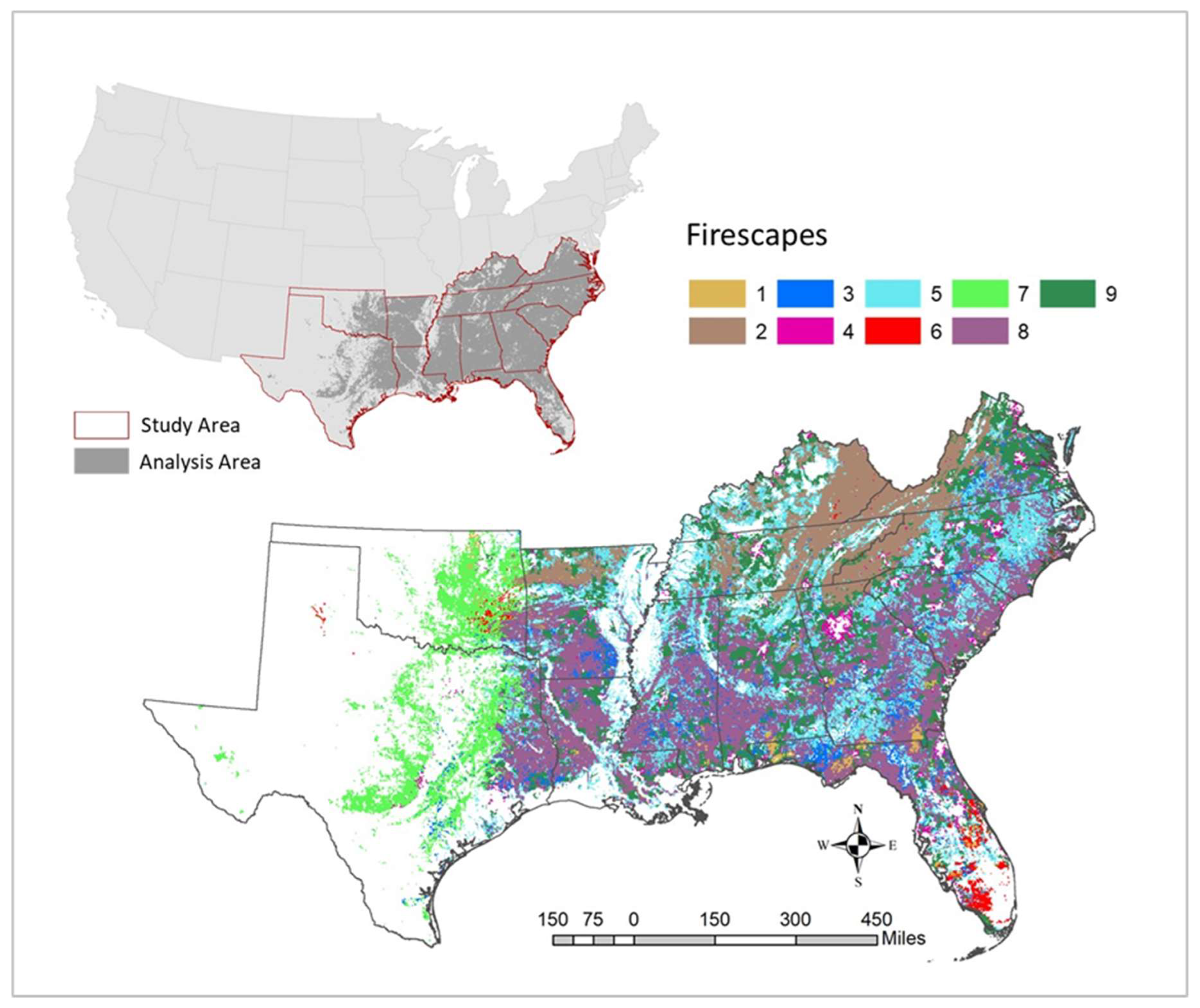
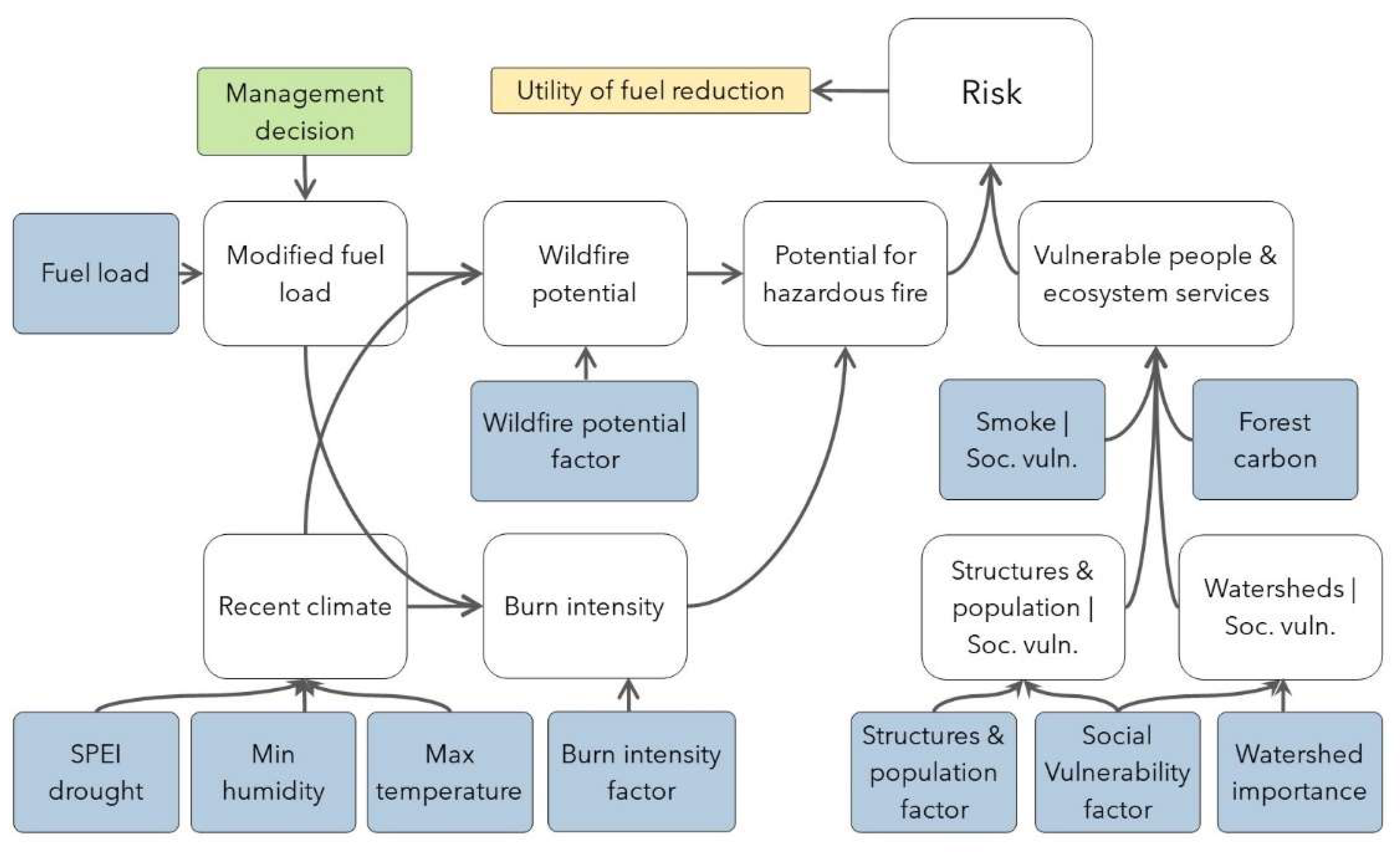
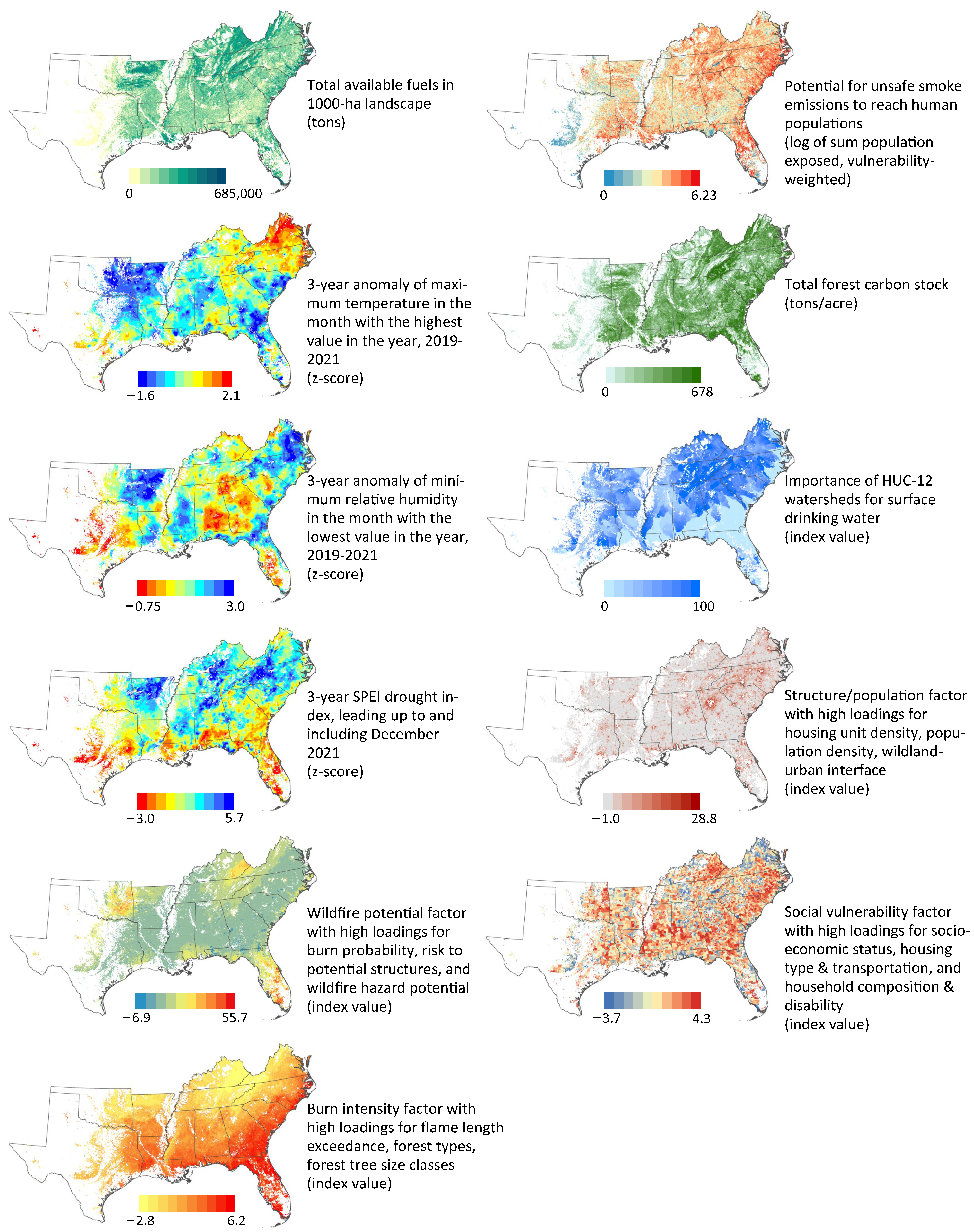

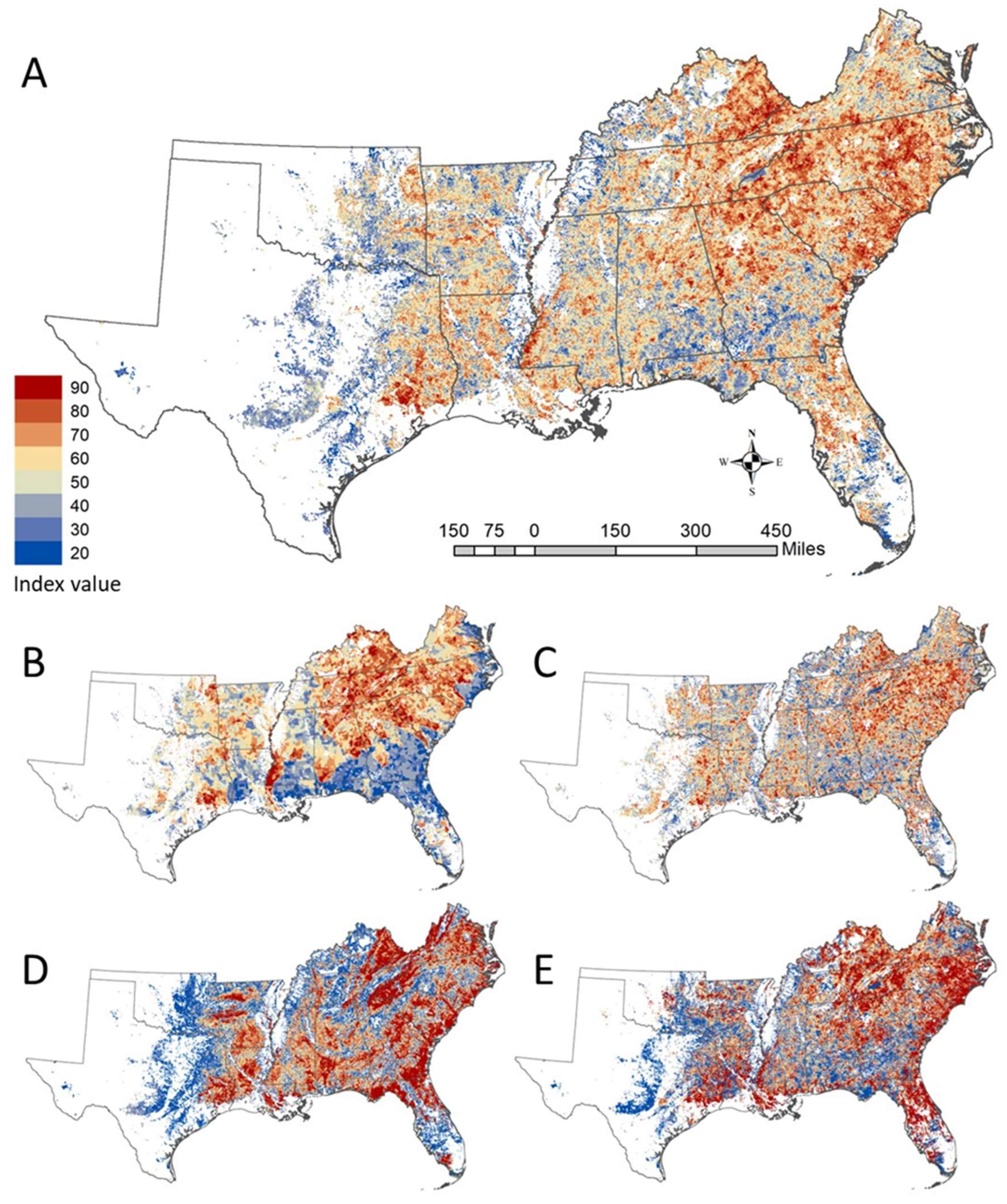
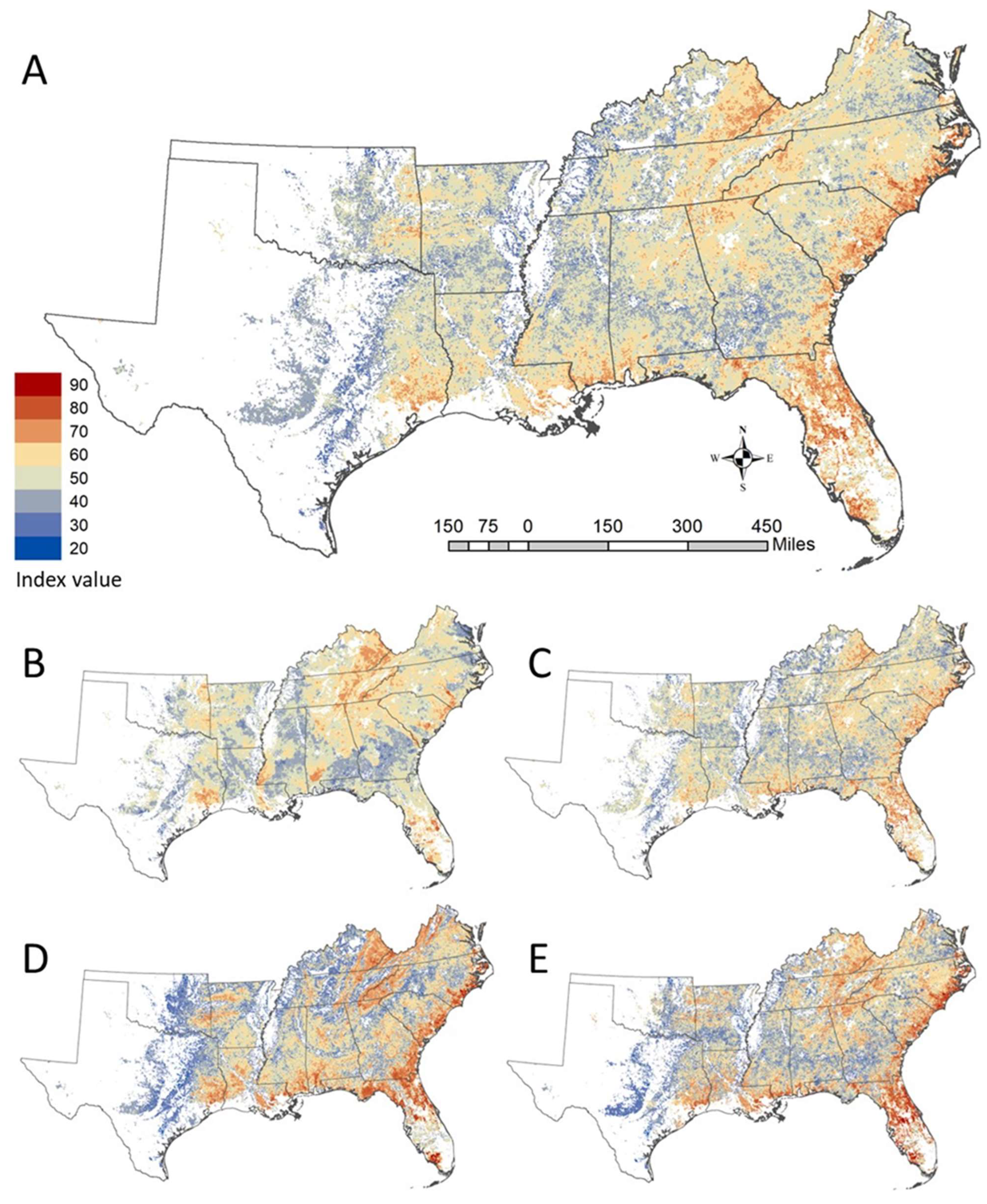
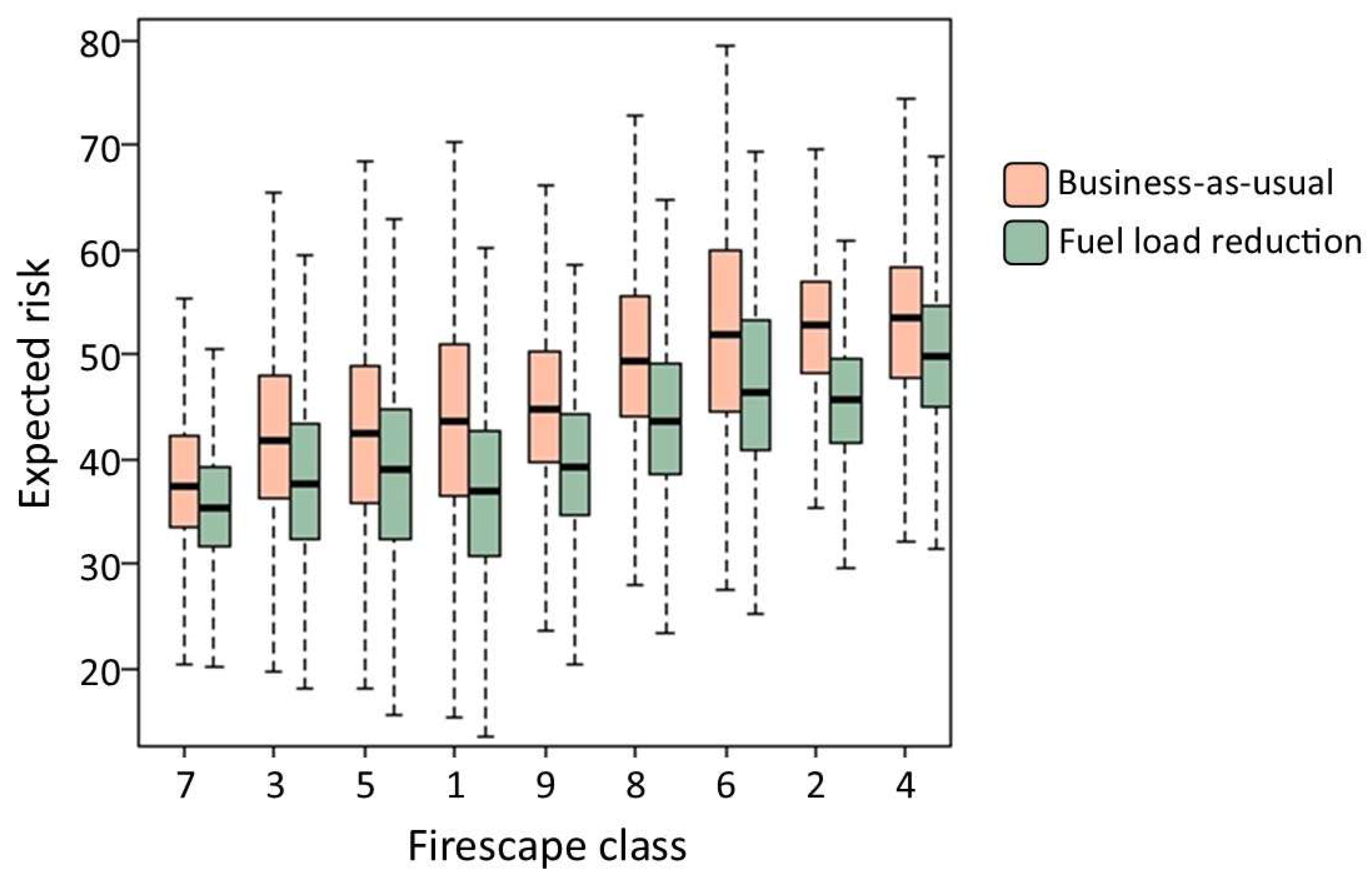
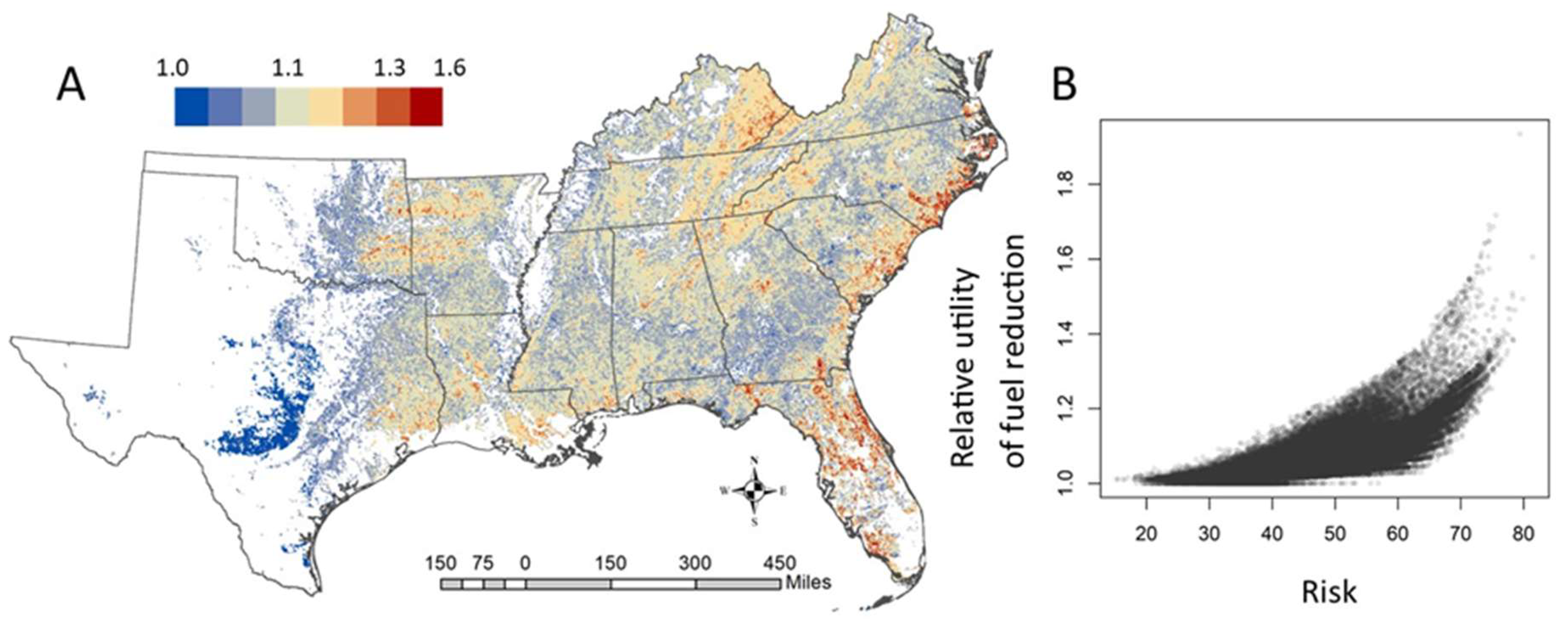
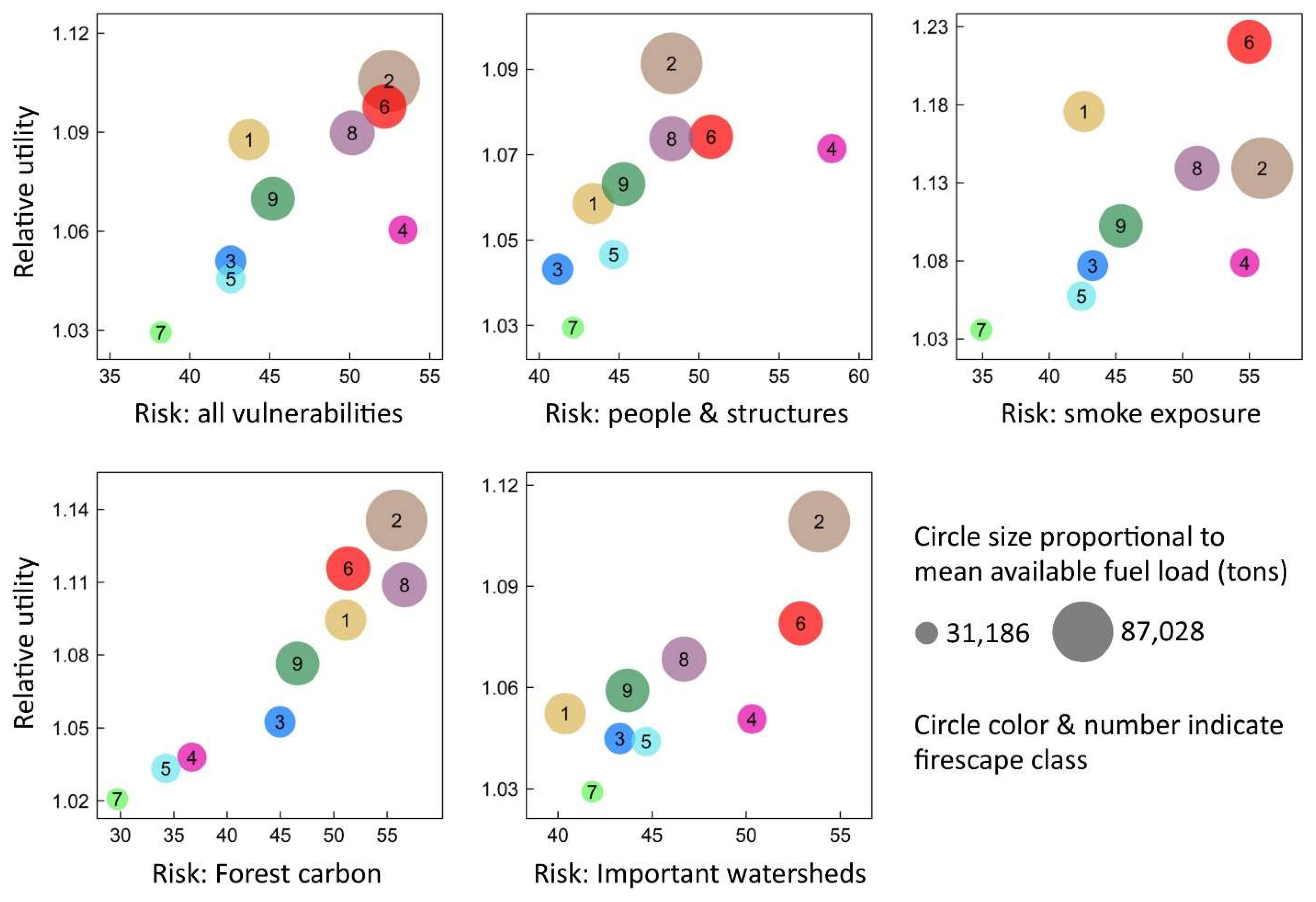
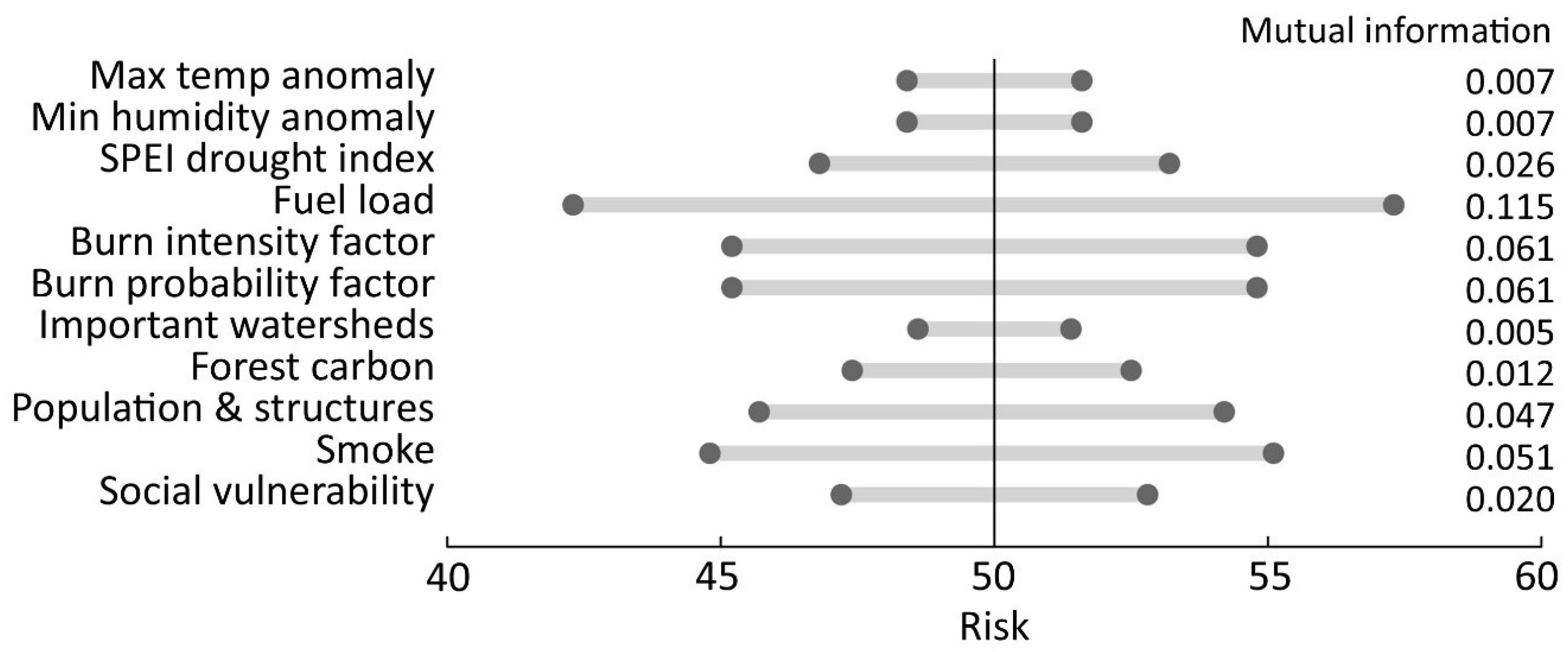

| Firescape | Description |
|---|---|
| 1 | History of wildfire, potential for intense fire |
| 2 | Cool and wet broadleaf mountain forests |
| 3 | Rural pine forest, conversion to agricultural lands |
| 4 | Urban periphery landscapes |
| 5 | Rural agriculture, vulnerable communities, and low wildfire potential |
| 6 | Rural mixed forests with hazardous fire potential |
| 7 | Warm and dry, mixed woodlands |
| 8 | Rural pine forests, intense fire and vulnerable communities |
| 9 | Semi-rural with low social vulnerability and moderate climate |
| Model Output | Minimum Rel. Humidity | SPEI Drought | Maximum Temperature | Total Fuel Load |
|---|---|---|---|---|
| Potential for hazardous fire | −0.01 | −0.32 | 0.06 | 0.51 |
| Overall risk | 0.064 | −0.074 | 0.13 | 0.54 |
| Risk to people and structures | 0.022 | −0.11 | 0.075 | 0.30 |
| Risk to people from smoke | 0.075 | −0.042 | 0.12 | 0.51 |
| Risk to forest carbon stocks | 0.12 | −0.077 | 0.11 | 0.61 |
| Risk to important watersheds | −0.042 | 0.071 | 0.13 | 0.40 |
| Relative utility of fuel reduction | 0.09 | −0.0042 | 0.077 | 0.69 |
Disclaimer/Publisher’s Note: The statements, opinions and data contained in all publications are solely those of the individual author(s) and contributor(s) and not of MDPI and/or the editor(s). MDPI and/or the editor(s) disclaim responsibility for any injury to people or property resulting from any ideas, methods, instructions or products referred to in the content. |
© 2023 by the authors. Licensee MDPI, Basel, Switzerland. This article is an open access article distributed under the terms and conditions of the Creative Commons Attribution (CC BY) license (https://creativecommons.org/licenses/by/4.0/).
Share and Cite
Nepal, S.; Pomara, L.Y.; Gould, N.P.; Lee, D.C. Wildfire Risk Assessment for Strategic Forest Management in the Southern United States: A Bayesian Network Modeling Approach. Land 2023, 12, 2172. https://doi.org/10.3390/land12122172
Nepal S, Pomara LY, Gould NP, Lee DC. Wildfire Risk Assessment for Strategic Forest Management in the Southern United States: A Bayesian Network Modeling Approach. Land. 2023; 12(12):2172. https://doi.org/10.3390/land12122172
Chicago/Turabian StyleNepal, Sandhya, Lars Y. Pomara, Nicholas P. Gould, and Danny C. Lee. 2023. "Wildfire Risk Assessment for Strategic Forest Management in the Southern United States: A Bayesian Network Modeling Approach" Land 12, no. 12: 2172. https://doi.org/10.3390/land12122172
APA StyleNepal, S., Pomara, L. Y., Gould, N. P., & Lee, D. C. (2023). Wildfire Risk Assessment for Strategic Forest Management in the Southern United States: A Bayesian Network Modeling Approach. Land, 12(12), 2172. https://doi.org/10.3390/land12122172









